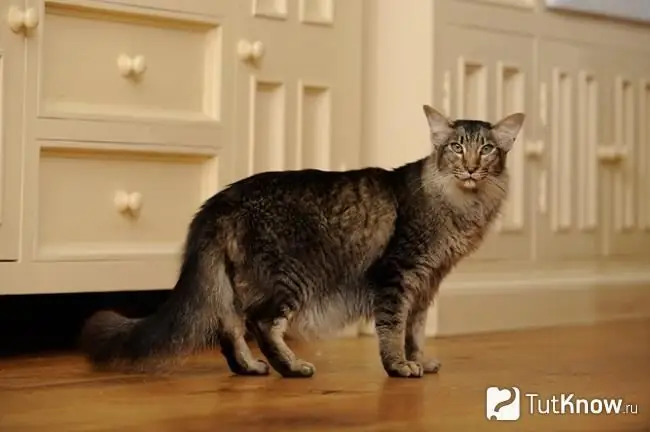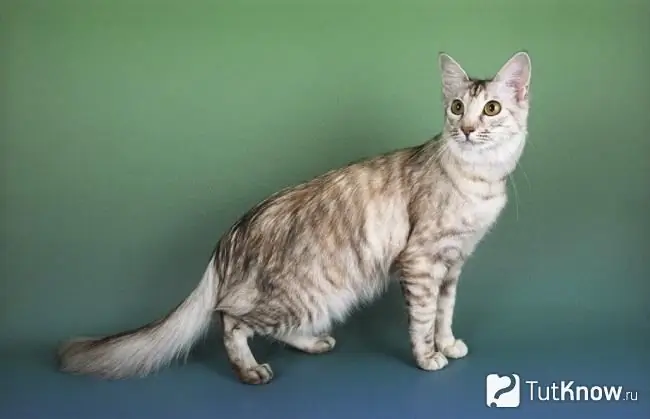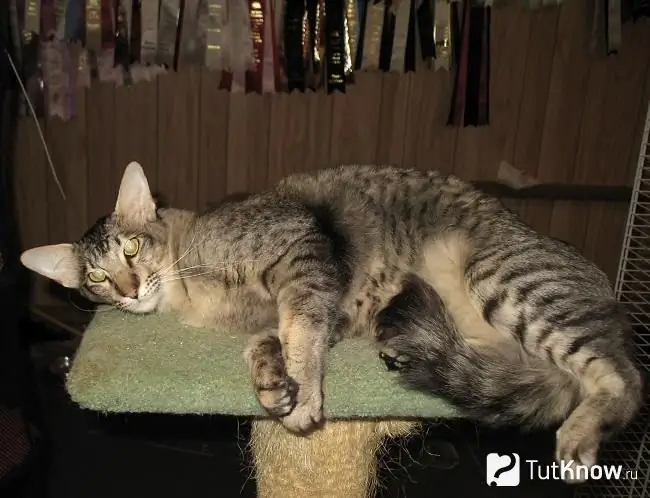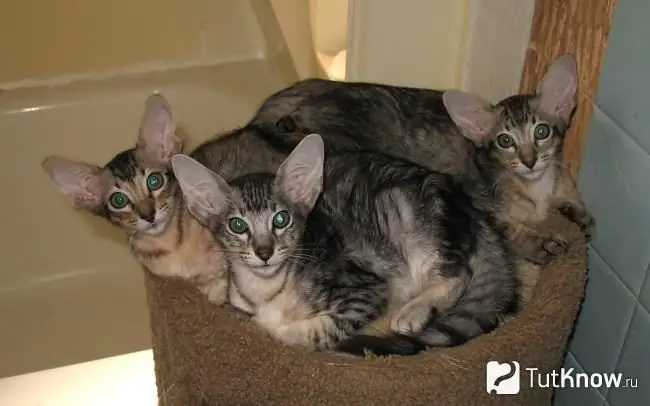The history of the breed, the standard of the variety of the oriental longhair cat, the temperament of the cats, health, advice on care: hygiene of the eyes, ears, nutritional habits, etc., the price of a kitten. Color - representatives of Oriental long-haired cat can fully boast of a variety of colors. But there are six basic and most common color options:
- Havanna or chocolate - this color implies a solid dark brown color scheme, with a matching nose tone and brownish-pink paw pads.
- Lilac or lavender the color variant includes a rich gray coat with some white bloom on the tips of the hairs, which resembles frost on a frosty day. The nose and pads on the legs are lavender.
- Blue color must be uniform, without any transitions of shades or minor patterns, even the nose is consistent with color.
- Cinnamon - this type of color means a pale brown tone with a pink nose and paw pads.
- Faun coloring - this is a beige, cream or silver color "fur" and pink nose and pads on the legs.
- Red color, in this version, the wool has a dark red color, even closer to red, but all the hairs should be colored in the same shade. The speculum and paw pads are pink.
Character features of the oriental longhaired cat

These cats are great for living in a city apartment, they love home comfort and absolutely do not need regular walks in the fresh air.
This breed is distinguished by a special affection for the owner, but the cat will not single out someone, he will love everyone, even the guests of your house will not be left without attention. Children for cats is a joy, this is an opportunity to regularly take part in active games and be in the spotlight, even the little pranks of babies are treated by pets with great patience.
The only drawback of Oriental long-haired cat is that loneliness is extremely difficult for them, so before bringing this furry into the house, think carefully if you can give it the proper amount of time and attention. It's another matter if you still have one of the four-legged animals, a cat or a dog - this is not particularly important, orientals, due to their natural sociability, get along well with both.
These cats are active and energetic, they love to play, run, climb somewhere to a height, it will be a cabinet or a refrigerator - they can do anything, with such powerful and long paws. But representatives of this breed are not famous for any harm, with age they lose their former craving for adventure, an adult cat can lie on the couch with an aristocratic look, and contemplate what is happening around him for a long time. But they are happy to play at any age, give them a toy and there will be no trace of this imposing calmness and balance.
Longhaired Oriental Health

A long-haired oriental cat by nature is the owner of good health and strong natural defenses of the body, with the help of timely vaccination, an equally stable acquired immunity is formed. With proper care and a balanced diet, these purrs live a long and happy life, lasting 15-18 years. However, there are some sores that can destroy all the health and cloudless life of the Oriental long-haired cat, they happen, fortunately, rarely, but you need to know and remember about them.
- Progressive retinal atrophy. In other words, the visual elements of the eye are gradually destroyed in a cat, which in consequence is fraught with partial or total blindness. This disease requires immediate medical intervention, because as soon as the sore touches the nerve endings of the eye, the process will become irreversible and there will be no chance of saving your pet. Unfortunately, it is not possible to diagnose this disease on its own, except at a late stage, when your cat no longer sees anything and hits the wall with its head. This pathology is not characterized by any external changes in the eyes, moreover, the animal quickly adapts to a gradual decrease in visual acuity. You need to periodically show your pet to a veterinarian who can examine the cat's visual organs and, in case of illness, notice it at an early stage that is still prone to treatment.
- Flat chest syndrome. This pathology is more related to small kittens, as it is noticeable from birth. If the kitten is still small and it seems that he just lies, then during the examination you should pay attention to the baby's breathing. It is usually more frequent and is given to the cat with great effort, since with this disease the lungs do not expand properly. Another sign of this syndrome is the location of the limbs, they are very wide apart and more like toad paws. The probability of death with this pathology is very high, but if the chest is only slightly altered, the chances of saving such kittens are quite high. Scientists have not yet figured out the exact cause of the flat chest syndrome, but in addition to genetic genesis, they also isolate malnutrition of a pregnant mother. Therefore, if you are breeding this breed, make sure that the pregnant cat has full care and, most importantly, balanced nutrition.
- Strabismus. This disease is better known as strabismus; all representatives of the Siamese-oriental group are more or less prone to it. This pathology can be both hereditary and acquired. The most common cause of acquired strabismus is injury. When keeping an oriental long-haired cat with sensitive eyes in the house, make sure that she does not play with sharp objects that can damage the muscles of the eye and that shampoo does not get into the eyes when bathing. He, of course, will not injure the cat, but the unpleasant sensations that will persuade the animal to get rid of them on their own, so that the pet can injure itself with its own paws.
Grooming a longhaired oriental cat

As for the care of the representatives of the breed, this is an animal for which the main thing is that there is proper care for its "fur coat" and that it is fed in a timely manner and correctly.
- Hair care must be appropriate and timely. Since long-haired orientals do not have an additional undercoat, their fur does not tend to get tattered. Therefore, it will be quite enough to comb the cat several times a week with a medium-hard brush with an average toothing. If your pet is not very willing to agree to the combing procedure, then you can purchase a special rubber glove to release the "fur coat" from dead hairs. It is sold in any pet store, its price is more than affordable and cats usually like it. This process is essentially the same as petting your cat, but also for the benefit of both the cat and your home. To keep your pet's fur always shiny, you need to bathe the Oriental long-haired cat once a month. He does not really like water, so it is better to accustom him to bathing days from early childhood. The best cleanser is shampoo for cats with dry skin. After taking a bath, try to dry the animal as best as possible with a towel and make sure that it does not fall into drafts or, worse, onto the balcony. No one has canceled colds yet.
- Dental hygiene. Although these cats do not often suffer from diseases of the teeth and gums, it will not hurt to periodically brush their teeth. If not with a toothbrush and toothpowder, feed your pet food for cleaning teeth at least once a week.
- Ear care. Examine the ears of the Oriental Longhair once every three to four days for sulfur build-ups and remove them as needed. Baby cotton swabs and a special cat ear cleaner will help you with this.
- Eyes - the place is quite vulnerable, so they need careful care. At least once a week, wipe the eyes with oriental cotton pads, previously soaked in a solution of boric acid, a weak solution of potassium permanganate (it should be pale pink in color), tea leaves (preferably yesterday), or a decoction of medicinal herbs. At the slightest alarming symptoms, such as lacrimation, purulent discharge, redness of the eye, it is better to go to the veterinarian for a consultation.
- Nutrition. These cats are slender in appearance, but you need to observe this slenderness. This breed is especially voracious. Therefore, you need to feed them often and in small portions, since they do not have the habit of leaving food in the plate and are prone to obesity. Your main diet can be premium ready-to-eat foods or homemade foods such as lean meats, organ meats, cereals, milk and dairy products, vegetables and chicken eggs.
Purchase and price of a longhaired oriental cat

There are several Oriental long-haired cat catteries in Russia, in particular, 3 of them are located in Moscow. The price of kittens is different, it all depends on the pedigree and on each kitten separately. The cost limits vary from 20,000 to 40,000 rubles.






